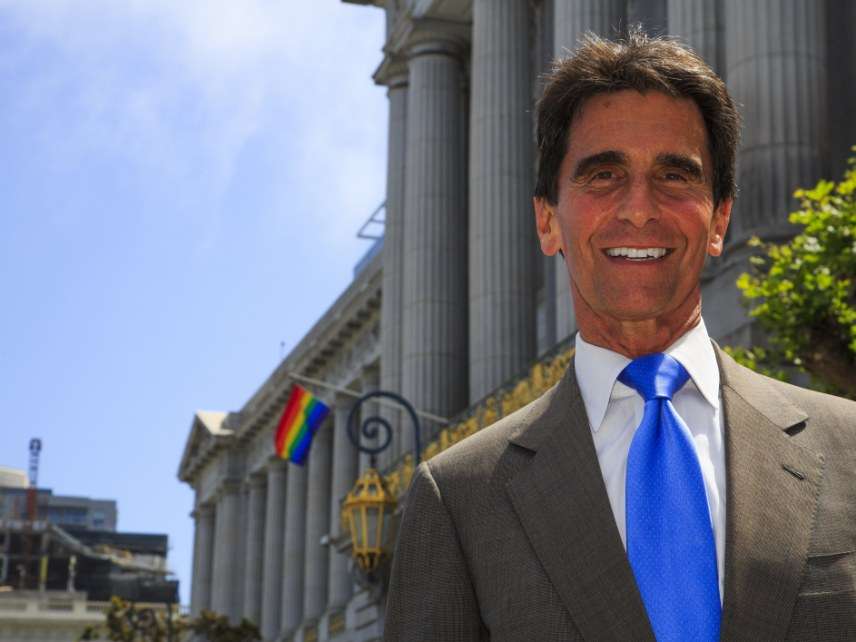San Francisco's Next Mayor Might Not Be the Person With the Most Votes
Golden Gate City voters ranked their choices for top office. And now the outcome is getting a little messy.

London Breed, president of San Francisco's Board of Supervisors and former acting mayor, indisputably won the popular vote for the city's mayoral race. The latest tally has her ahead of rival Mark Leno with a difference of 35 percent to 26 percent in a crowded field of eight choices.
But due to the city's electoral system it's looking increasingly like Leno is actually going to be named the winner of the election. This is not an accident or a mistake. This is how the voting system works.
San Francisco uses what's known as a "ranked choice" voting system, implemented in 2004, as a way of (hopefully) better representing the interests of the greatest number of voters and to make sure that a candidate wins with a majority of the votes, not just the plurality.
In San Francisco, rather than just deciding a winner, voters are asked to rank candidates by preference. When the votes are tallied, if nobody gets more than 50 percent of the votes, the candidate with the least votes gets eliminated. Then the votes are tallied again, but for those who voted for the eliminated candidate, their second choice is now tallied instead. And so it goes, until one candidate claims a majority vote, not just the plurality.
While Breed got the plurality of the initial votes, Leno was a popular second and third choice for voters whose first choice candidate was eliminated. As of this morning, Leno has a bare majority of the vote, 50.4 percent to Breed's 49.6 percent. Leno picked up thousands more votes as candidates were eliminated than Breed. But with less than 1,500 votes separating the two of them and many more ballots to still tally, it may be days before we know for certain who actually wins.
The ranked choice system is not flawed if, or because, Breed ends up losing. Ranked choice voting exists as an alternative to America's winner-takes-all voting system, which tends to benefit incumbents and entrenched parties and makes voting for independent and third-party candidates a tough proposition. In ranked choice voting, you're not "throwing your vote away" if you vote for somebody from the Libertarian Party, or Green Party, or Communist Party, or who isn't a member of any party at all. With ranked choice voting, you can now vote for the longshot and also for alternative candidates who are more likely to win.
This is an excellent way to encourage voter participation among those who feel disenfranchised by systems where you might as well stay home if you're not going to vote for the bigger names. FairVote, an advocacy group that encourages "ranked choice" voting (and whose board is led by former Nirvana bassist Krist Novoselic), supports San Francisco's system. In a piece posted on their site June 1, Pedro Hernandez notes:
Ranked choice voting offers a proven solution for voters. RCV played a key role in last year's exciting high turnout mayoral and city council wins in Minneapolis and St. Paul by people of color, LGBTQ candidates, and other underrepresented communities. Bay Area's four cities with RCV have seen significant increases in representation of women and people of color. When San Franciscan first adopted RCV, it led the nation on a plethora of social issues, and voting in a fair, inclusive process is part of that progress.
RCV is easy for voters. In San Francisco, we have the opportunity to rank our favorites, and choose two backups should my first choice lose. That power should extended to all voters throughout California and the country. When voters have a greater choice through RCV, election outcomes at all levels become more representative of the electorate.
While ranked choice voting can help diminish the issue of "spoiler" candidates—those who are similar enough to another candidate to draw votes away, causing both candidates to lose—ranked choice voting can result in a new set of concerns and political gaming. In this case, San Francisco saw the opposite problem of "vote-splitting." Leno openly campaigned with fellow mayoral candidate Jane Kim and encouraged their supporters to also choose to list the other candidate as their second choice. Kim came in third place in the vote, and when she was eliminated, that's how Leno got all the votes pushing him ahead of Breed. So two candidates working together have the potential to play "spoiler" for a third. (Of interest to Reason readers: Breed was also the candidate with a reputation for being more open to development to solve the city's housing shortage.)
And then there's the issue of what happens to the ballots of voters who don't rank the top candidates at all. Those ballots get "exhausted" and are tossed out. Voters who ranked neither Leno nor Breed have been tossed from the tally, just like a typical winner-takes-all ballot. According to the election figures, that currently counts out to more than 13,000 ballots.
Does that matter? Well, if the point of ranked choice voting is to make sure the winning candidate has a majority of the voters' support, that's not what's going to happen in this race. Leno will only have the "majority" of the vote because of all the ballots that have been eliminated or "exhausted" for not selecting either him or Breed. In the end, regardless of who wins, they technically will still have less than 50 percent of the vote.
The better determinant of success might be whether San Francisco voters feel like the winning candidate has the support of enough citizens. That can be a challenging thing measure when the candidate with the most votes in the first round ends up losing.


Show Comments (102)